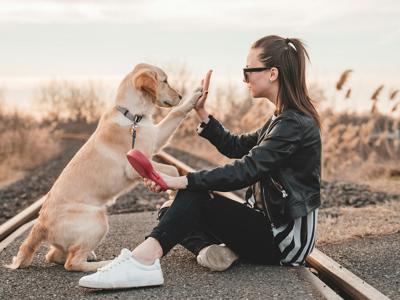
Ignacio Amenábar
Forget sightseeing and exploring new places: Two in five dog owners said the best part of a trip is coming home — to see their pup.
That’s according to a new survey of 2,000 dog owners, which revealed 42% said coming home to their dog can be the part of their trip they enjoy the most.
Forty percent of respondents “constantly” worry whether their dog is okay when they’re traveling — and a fifth (22%) miss their dog so much while traveling that it can impact their enjoyment of the trip.
Conducted by Talker Research and commissioned by K9 Resorts, the results highlighted Americans’ love for their furry companions and the immense worry that comes from being away from their pets.
It only takes 53 minutes for the average respondent to start missing their pup when they have to leave their dog. But for some, this kicks in even sooner, with 24% of respondents admitting they start thinking about their dog as soon as they walk out the door.
When traveling, the average respondent estimated their vacation distracts them for just an hour and a half at a time before “pet parent guilt” strikes hardest. From there, pet owners miss their pups an average of 13 distinct times per day when away.

This highlights the importance of owners ensuring their dogs are well cared for when they’re away, to help make this worry more manageable.
In fact, three-quarters of dog owners surveyed (76%) said their summer travel plans primarily depend on finding proper care for their dog.
Finding the right care is crucial for pet parents, as 32% worry no one else will fully understand what their dog needs — and the same percentage was concerned their dog won’t get enough walks, stimulation or playtime in their absence.
A similar percentage also expressed worry that their dog won’t get the love they deserve if they aren’t around (34%).
This worry has led to a fifth (19%) asking their pet sitter to put their dog on the phone so they can speak to their pup — while 17% have done the same with a video call.
“Dogs are true family members, and we understand the anxiety pet owners feel when they are traveling and can't bring their pups with them,” said Steven Parker, co-CEO and co-founder of K9 Resorts Luxury Pet Hotel and Daycare.
“Our expert staff of dog lovers goes above and beyond to make sure your best friend is treated like family. Our clients know they can rest assured their dogs are enjoying a fabulous staycation while they're away."
More than half of those surveyed wish they could explain to their dog why they can’t come and reassure them that they’ll be back (52%).
The survey looked at just how pet parents build this level of understanding and communicate with their furry friends, finding that 84% claim they can read their pet’s expressions, and a similar percentage can differentiate their needs by the slightest change in whines or barks (86%).
Pet parents have such a good read on their pet that one in five claim they “always” know what their dog is going to do before they do it.
Despite knowing their pet’s personality, the average respondent worries about whether they’re meeting their dog’s needs three times a week. Twice the number of dog owners surveyed worry about their dog’s needs more than their own (40% vs. 19%).
Respondents are particularly keen on making sure their dog gets enough exercise (44%), that their overall health is good (43%) and ensuring they get enough affection (37%).
However, fewer pet parents recognize the importance of ensuring that their dog has enough socialization (29%) and mental stimulation (28%).
“Pet parents naturally think of nutritious meals and exercise as essential components of their dog’s well-being, but being properly socialized and receiving mental stimulation is just as important,” said Parker. “If they aren’t already, I recommend to dog parents that they identify ways to incorporate these elements into their dogs’ daily routines — whether that’s through boarding and daycare, trips to the dog park, or play dates.”

Josh Rakower
WHAT WOULD MAKE RESPONDENTS’ DOGS THE HAPPIEST IN THE WORLD?
- “More carrots as treats.”
- “Having a huge backyard to run around in.”
- “A long walk every single day.”
- “A pool.”
- “Never-ending ball throwing.”
- “A bone as big as him.”
- “Home-cooked food every day.”
- “As many treats as he could possibly eat.”
- “His own rope swing.”
- “Endless belly rubs.”
- “Having filet mignon mixed in with his usual dry dog food.”
- “Tons of attention.”
- “A lifetime supply of squirrels to chase (but never catch)!”
- “Lots of balls to chase.”
- “Endless bacon.”

Chelsea Audibert
“NEW” THINGS PET OWNERS HAVE LEARNED ABOUT THEIR DOG
- “When she is happy she rolls on her back.”
- “She can detect when my other dog is going to have a seizure before she has it.”
- “She paws me when she wants to be petted.”
- “When he's nervous he will bite at my leg.”
- “He is afraid of the dark.”
- “Afraid of storms as she gets older.”
- “I recently learned my dog understands over 20 words, including toy names, showing surprising intelligence and emotional awareness during play and daily routines.”
- “My dog loves playing with puzzle toys to stay mentally active.”
- “She puts shoes in my lap when she wants to play frisbee outside.”
- “She gets cold about 3 or 4 in the morning and wants to cuddle under the blankets.”

Richard Brutyo
Survey methodology:
Talker Research conducted two surveys, each with 2,000 dog owners; both were commissioned by K9 Resorts and administered and conducted online by Talker Research. The first was filled between April 28 and May 5, 2025, and the second was filled between June 11 and June 16, 2025.
We are sourcing from a non-probability frame and the two main sources we use are:
- Traditional online access panels — where respondents opt-in to take part in online market research for an incentive
- Programmatic — where respondents are online and are given the option to take part in a survey to receive a virtual incentive usually related to the online activity they are engaging in
Those who did not fit the specified sample were terminated from the survey. As the survey is fielded, dynamic online sampling is used, adjusting targeting to achieve the quotas specified as part of the sampling plan.
Regardless of which sources a respondent came from, they were directed to an Online Survey, where the survey was conducted in English; a link to the questionnaire can be shared upon request. Respondents were awarded points for completing the survey. These points have a small cash-equivalent monetary value.
Cells are only reported on for analysis if they have a minimum of 80 respondents, and statistical significance is calculated at the 95% level. Data is not weighted, but quotas and other parameters are put in place to reach the desired sample.
Interviews are excluded from the final analysis if they failed quality-checking measures. This includes:
- Speeders: Respondents who complete the survey in a time that is quicker than one-third of the median length of interview are disqualified as speeders
- Open ends: All verbatim responses (full open-ended questions as well as other please specify options) are checked for inappropriate or irrelevant text
- Bots: Captcha is enabled on surveys, which allows the research team to identify and disqualify bots
- Duplicates: Survey software has “deduping” based on digital fingerprinting, which ensures nobody is allowed to take the survey more than once
It is worth noting that this survey was only available to individuals with internet access, and the results may not be generalizable to those without internet access.
















